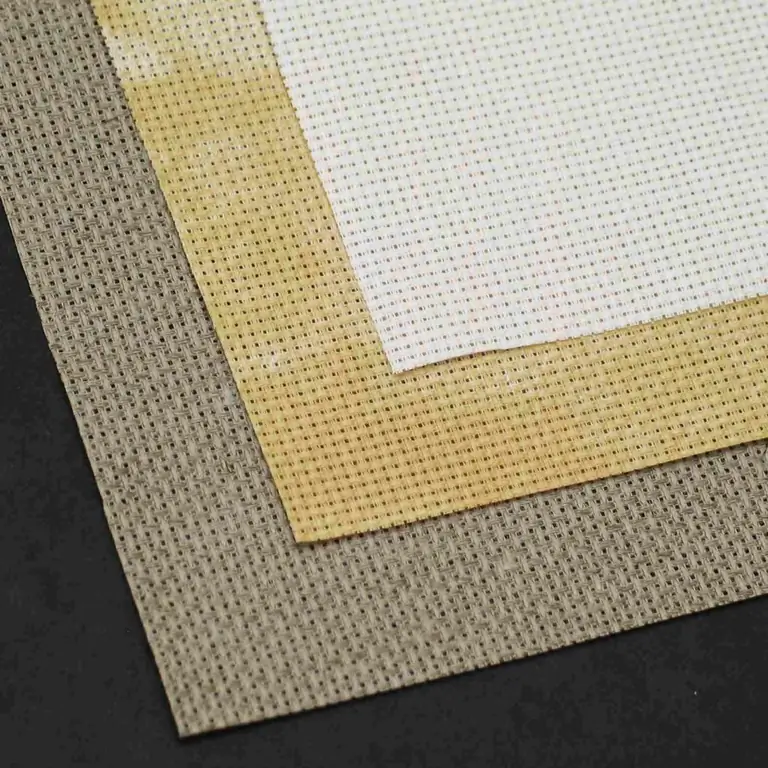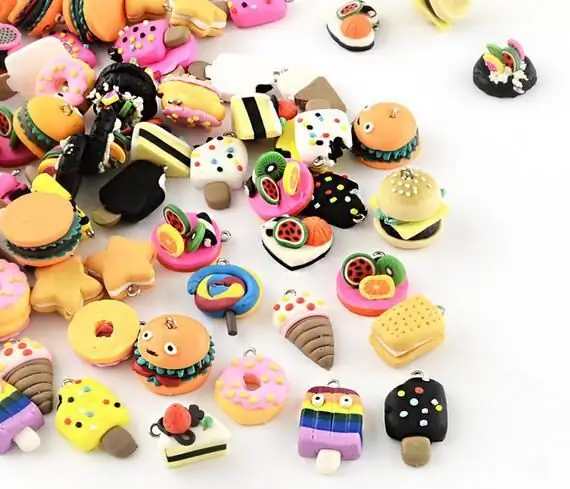
Inhaltsverzeichnis:
- Autor Sierra Becker [email protected].
- Public 2024-02-26 04:45.
- Zuletzt bearbeitet 2025-01-22 22:11.
Einführung einer Meisterklasse zur Herstellung von Beeren aus Fimo. Schauen wir uns die Grundlagen der Herstellung am Beispiel von Himbeeren an und kreieren Himbeerohrringe, die ein großartiges Accessoire sein werden. Und dann werden wir versuchen, Erdbeeren und Blaubeeren für ein schönes Armband oder einen Anhänger zu machen. Es gibt nichts Schwieriges. Das Wichtigste ist, den Anweisungen und Empfehlungen Folge zu leisten.
Werkzeuge und Materialien
Wir werden mit einem Material arbeiten, das bei hoher Temperatur gebrannt werden muss. Um Beeren aus Fimo herzustellen, bereiten Sie die folgenden Werkzeuge und Materialien vor:
- Polymer Clay durchscheinende rubinrote Farbe;
- grün;
- umbra gebrannt;
- transparenter flüssiger Fimo;
- Papiermesser;
- Silikonform;
- Zange;
- iglu;
- Ohrclips;
- Feuchttücher;
- schwamm.
Achten Sie darauf, Ihre Hände zu waschen und die Arbeitsfläche mit feuchten Tüchern abzuwischen, bevor Sie mit der Arbeit beginnen.
Wie man Himbeeren macht
Betrachten wir den Prozess der Herstellung von Beeren aus Fimo (Foto unten).
- Ein Stück roten Fimo kneten.
- Zu einer 2 mm dicken Wurst rollen und in Stücke schneiden.
- Forme sie zu Kugeln und dann zu Tröpfchen, die bald unsere Himbeeren werden.
- Befestige die Tröpfchen aneinander und ordne sie in einer Spirale an. Versuchen Sie, nicht zu fest zu drücken, um sie zu glätten. Eine Beere formen.
- Machen Sie mit einer Nadel oben ein kleines Loch (damit Sie die Ohrringe befestigen können).
- Die Beeren auf den Biskuit legen und 15 Minuten bei 130 Grad backen. Nach dem Backen wird der Ton dunkler und gesättigter.
- Die Beeren aus dem Ofen nehmen und vollständig abkühlen lassen.
- Jetzt machen wir die Blätter. Mischen Sie dazu grünen und braunen Ton, um einen angenehmen Kräuterton zu erh alten, der so naturnah wie möglich ist.

Wie man Beerenblätter macht
Für die Blattbildung benötigen Sie eine spezielle Silikonform. Verwenden Sie für jeden ein kleines Stück grüne Masse. Denken Sie daran, dass Sie für eine Fimo-Beere 3-5 Blätter machen müssen.
Tragen Sie flüssigen Fimo auf die Basis jeder Himbeere auf und befestigen Sie die Blätter. Danach müssen die Beeren weitere 20 Minuten bei einer Temperatur von 130 Grad gebacken werden.
Wenn sie abgekühlt sind, stecken Sie die Ohrhaken in die vorbereiteten Löcher in jedem Produkt. Verwenden Sie der Einfachheit halber eine Zange. Deine Ohrringe sind fertig!
Weintrauben, Moltebeeren oder Brombeeren können Sie auf ähnliche Weise herstellen. Beeren aus Fimo sehen nicht nur an Ohrringen, sondern auch an anderen Arten von Schmuck schön aus: Armbänder, Anhänger, Kränze. Viele kombinieren sie zu Beeren-Frucht-Kompositionen.

Lassen Sie uns versuchen, ein Accessoire mit verschiedenen Arten von Fimo-Beeren zu kreieren. Dazu lernen wir, wie man Erdbeeren und Blaubeeren herstellt. Der Prozess der Erdbeerherstellung ist etwas komplizierter, also fangen wir damit an.
Und bereiten Sie zuerst alle notwendigen Werkzeuge vor und reinigen Sie die Arbeitsfläche.
Wie wählt man Lehm für Erdbeeren
Die Farbe des Tons für den Hauptteil der Beere kann unterschiedlich sein, einige Meister verwenden sogar Gelb. Aber häufiger kommt natürlich Rosa oder Rot zum Einsatz. Wenn nach der Herstellung von Himbeeren roter Fimo übrig bleibt, können Sie ihn verwenden.
Du brauchst auch viel weiße Farbe, um die Oberseite der Erdbeere aufzuhellen und sie natürlicher aussehen zu lassen. Blätter können aus der gleichen Mischung hergestellt werden, die von Himbeeren übrig bleibt. Oder wählen Sie einen anderen Grünton.
Um zu arbeiten, brauchst du eine Nadel, einen Zahnstocher oder ein Werkzeug mit einer scharfen Spitze. Sogar ein Druckbleistift tut es. Die Größe der Beere muss nicht der echten entsprechen. Sie können sehr kleine Erdbeeren machen und sie in einer Dekoration kombinieren. Es hängt alles von Ihrem Geschmack und Ihren Wünschen ab.

Polymer Clay Beeren: Workshop zur Erdbeerherstellung
Zuerst musst du den Ton in deinen Händen kneten und eine kleine Kugel formen. Größe jeweilswählt selbstständig aus.
Erdbeeren sind tropfenförmig. Daher bilden wir aus der Kugel ein Oval mit einem Kegel auf einer Seite.
Damit Beeren aus Fimo natürlicher aussehen, verwenden wir in unserer Arbeit auch viel weiße Farbe. Es dauert ziemlich lange - um die Farbe an den Rändern, an der Basis und an der Spitze zu ändern. Glätten Sie die Gelenke vorsichtig mit dem Finger. Es dürfen keine Lücken entstehen. Farben gehen nahtlos ineinander über.
Aussehen des Beerenrohlings ändern
Als nächstes musst du die Samen auf den Erdbeeren darstellen. Sie benötigen ein Werkzeug mit einer scharfen Spitze. Es ist wünschenswert, dass es eine dreieckige Form hat. Mit sanften Bewegungen machen wir kleine Kerben über die gesamte Oberfläche, um das Werkstück nicht zu beschädigen.
Für die Blätter verwenden wir eine Silikonform. Sie können dasselbe wie für Himbeeren nehmen, aber die Blütenblätter selbst müssen etwas länger gemacht werden, damit sie die Beeren bedecken. Alternativ können Sie die Blätter auch von Hand modellieren, in diesem Fall können sie jedoch unterschiedlich groß und nicht zu symmetrisch ausfallen. Wer es mag, kann auf eine Silikonform verzichten.
Wir befestigen die fertigen Blätter an der Spitze der Beere und machen dann dünne Würste aus grünem Ton und formen daraus Pferdeschwänze. Machen Sie die notwendigen Löcher. Die Beeren sind fertig.
Jetzt können sie gebacken und für Accessoires verwendet werden.

Wie man Blaubeeren aus Fimo macht
Heidelbeeren aus Fimo herzustellen ist sehr einfach. Der schwierigste Schritt ist immerrichtig schwarz und blau. Dies kann durch die Kombination von blauem, violettem und schwarzem Ton erreicht werden. Sie können ein paar Beeren unreif machen: grünlich und rosa-lila.
Die Masse vorsichtig kneten und mischen. Wir teilen uns in Teile und rollen kleine Erbsen mit leicht abgeschnittener Oberseite auf. Es ist besser, wenn sie unterschiedlich groß sind, wie im Leben.
Zum Arbeiten brauchst du einen Zahnstocher. Mit seiner Hilfe müssen Sie auf dem Schnitt ein Loch in Form eines Sternchens formen. Eigentlich ist dies das Ende der Arbeit. Jetzt weißt du, wie man Beeren aus Fimo macht. Es bleibt nur, Löcher zu bohren und Blaubeeren bei einer Temperatur von 130 Grad 20 Minuten lang zu backen.

Wenn die Produkte abgekühlt sind, führen Sie einen Haken in jedes von ihnen ein und verbinden Sie es mit einem Armband oder befestigen Sie es an einem anderen Zubehör.
Solcher Schmuck ist besonders beliebt bei jungen Fashionistas. Helle Farben passen gut zu Sommeroutfits.
Empfohlen:
Wie man auf eine Uniform stickt: eine Meisterklasse für Anfänger. Einheitliche Kennzeichnung

Wie bestickt man eine Uniform? Und was ist es überhaupt? Nicht jeder, der Nähen lernt, hat Interesse daran, Sticken zu lernen. Einige Menschen sind von der Vielf alt der Stiche eingeschüchtert, während andere es vorziehen, den Prozess nicht zu einfach zu machen. Wenn Sie neu in der Welt der Handarbeit sind, fragen Sie sich wahrscheinlich, welchen Stoff Sie für Handstickereien verwenden sollen
Tipps für Anfänger: wie man mit Polymer Clay arbeitet. Benötigte Materialien und Werkzeuge, Arbeitstechnik

Eines der beliebtesten kreativen Materialien ist Fimo. Daraus entstehen Schmuck, Souvenirs, Spielzeug usw. Um die Technik der Arbeit mit Fimo zu beherrschen, müssen Sie den Rat erfahrener Handwerker berücksichtigen. Es gibt viele Feinheiten und Nuancen, deren Kenntnis es Ihnen ermöglicht, schwerwiegende Fehler zu vermeiden. Überlegen Sie als Nächstes, welche Meister Anfängern Ratschläge geben und wie man mit Fimo arbeitet
Wie erstelle ich DIY Polymer Clay zu Hause?

Viele Kinder basteln gerne Fimo, aber die Ladenversion einer solchen Masse ist nicht sehr billig. Machen Sie Ihre eigenen Sachen zu Hause. Alle Produkte sind einfach zu kaufen, die Kosten sind minimal und die Produktionszeit beträgt nur wenige Stunden. Wenn Sie Fimo mit Ihren eigenen Händen herstellen, können Sie außerdem sicher sein, dass das Kind mit einem umweltfreundlichen Produkt spielt
Wie erstelle ich einen DIY Polymer Clay Schlüsselanhänger

Denkst du daran, einen Schlüsselanhänger zu kaufen? Beeil dich nicht. Es ist einfach, es selbst zu tun. Von was? Aus Fimo. Schlüsselanhänger können unterschiedlich gest altet werden, alles hängt von Ihrer Geschicklichkeit im Umgang mit dem Material und von Ihrer Ausdauer ab. Unten finden Sie Ideen, was zu tun ist
So erstellen Sie Origami-Beeren: Technik, Beschreibung, Anleitung

Grundregeln für Orgins. Wie ist modulares Origami entstanden? Wie kann man Origami-Beeren selber machen? Schritt-für-Schritt-Anleitung
